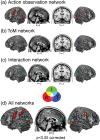Neural processing of social interaction: Coordinate-based meta-analytic evidence from human neuroimaging studies
- PMID: 31077492
- PMCID: PMC6865826
- DOI: 10.1002/hbm.24627
Neural processing of social interaction: Coordinate-based meta-analytic evidence from human neuroimaging studies
Abstract
While the action observation and mentalizing networks are considered to play complementary roles in understanding others' goals and intentions, they might be concurrently engaged when processing social interactions. We assessed this hypothesis via three activation-likelihood-estimation meta-analyses of neuroimaging studies on the neural processing of: (a) social interactions, (b) individual actions by the action observation network, and (c) mental states by the mentalizing network. Conjunction analyses and direct comparisons unveiled overlapping and specific regions among the resulting maps. We report quantitative meta-analytic evidence for a "social interaction network" including key nodes of the action observation and mentalizing networks. An action-social interaction-mentalizing gradient of activity along the posterior temporal cortex highlighted a hierarchical processing of interactions, from visuomotor analyses decoding individual and shared intentions to in-depth inferences on actors' intentional states. The medial prefrontal cortex, possibly in conjunction with the amygdala, might provide additional information concerning the affective valence of the interaction. This evidence suggests that the functional architecture underlying the neural processing of interactions involves the joint involvement of the action observation and mentalizing networks. These data might inform the design of rehabilitative treatments for social cognition disorders in pathological conditions, and the assessment of their outcome in randomized controlled trials.
Keywords: action observation network; activation likelihood estimation; amygdala network; mentalizing network; meta-analysis; mirror network; social cognition rehabilitation; social interaction network.
© 2019 Wiley Periodicals, Inc.
Conflict of interest statement
The authors have no conflict of interest to declare.
Figures


References
-
- Abraham, A. , Rakoczy, H. , Werning, M. , von Cramon, D. Y. , & Schubotz, R. I. (2010). Matching mind to world and vice versa: Functional dissociations between belief and desire mental state processing. Social Neuroscience, 5, 1–18. - PubMed
-
- Aichhorn, M. , Perner, J. , Weiss, B. , Kronbichler, M. , Staffen, W. , & Ladurner, G. (2009). Temporo‐parietal junction activity in theory‐of‐mind tasks: Falseness, beliefs, or attention. Journal of Cognitive Neuroscience, 21, 1179–1192. - PubMed
-
- Akitsuki, Y. , & Decety, J. (2009). Social context and perceived agency affects empathy for pain: An event‐related fMRI investigation. NeuroImage, 47, 722–734. - PubMed
Publication types
MeSH terms
LinkOut - more resources
Full Text Sources
Medical

